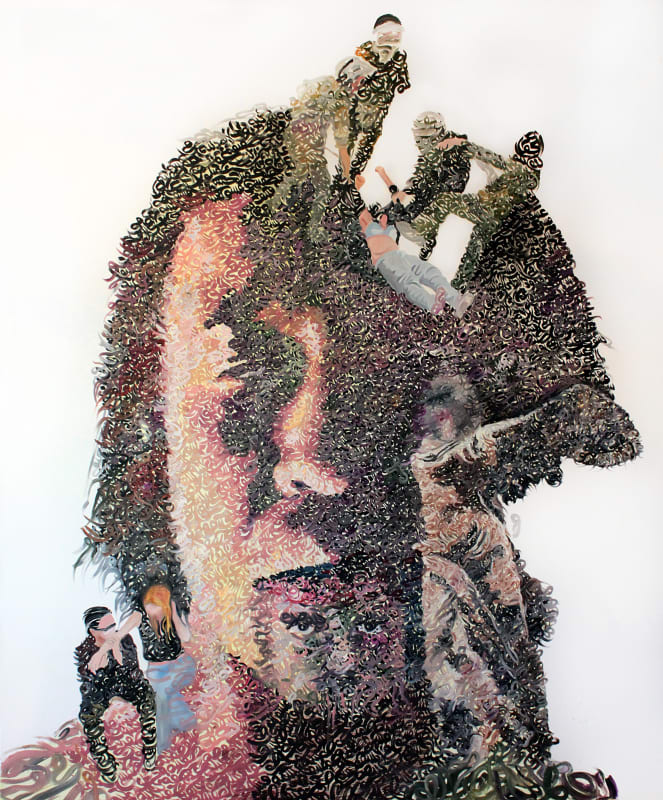Artspace Gallery Hosts an Exclusive Exhibition for Acclaimed Moroccan Artist Zakaria Ramhani and Presents the Global Launch of William Wagner Geneva.
The prestigious Dubai-based ARTSPACE Gallery will hold an exhibit for the renowned Moroccan Artist Zakaria Ramhani, entitled Connotation. ARTSPACE is committed to the promotion of contemporary Middle Eastern art and artists. The gallery is a regional leader and its second location in London caters to its extensive global clientele while bridging the gap between the eastern and western art scenes. We are also pleased to announce our collaboration with William Wagner Geneva, a luxury brand of Time Keeper and instrument of writing.
Zakaria Ramhani was born in Tangier in 1983. The son of a painter, he discovered very early the different painting techniques in his father’s studio. Deeply influenced by the way the religious conservatives criticized his father for making figurative art, Zakaria Ramhani chose to use and transform the Islamic tradition of calligraphy, whose abstract nature allowed artists to avoid violating the prohibition against figurative representation. Zakaria Ramhani got his diploma to become a fine art teacher in Tangier in 2003, and worked as a teacher, before giving up his work to devote himself entirely to his paintings. In his own words he speaks very candidly about his work:
“I do not paint; I create faces, emotions and moods in my mother tongue. I see the painting in the history of Western art as a possibility and not finality. I see my approach as an encounter of artistic legacies from different civilizations. My work is primarily based on the use of writing, calligraphy and letters in Arabic, sometimes juxtaposed in French or English, to create figurative paintings- most of which are dedicated to portraits. I can recall becoming fascinated and intrigued by figurative paintings and portraits at a very young age through the practice of my father who is also a painter. I quickly realized this particular practice was against aniconicism in Islam and is also found in Judaism.
I remember my father praying to Allah for forgiveness when he agreed to make a portrait, which was often commissioned, before a ban imposed on himself from painting all living things in our neighborhood. Some faithful believers had an understanding of the soothsayer’s message and refused to speak to him because they thought he was committing a great sin. This guilt that I probably inherited naturally nourishes a desire to re-invent a unique way of painting in order to create a representation while not being fearful.
The title of this exhibition Connotation perfectly captures the complex relationship between images and words. The connotation is difficult to define because it is the set of elements of a sign and is not only a reduced literal meaning. Signs or words that have the meaning "denoted" can be found in the dictionary. Some portraits of public figures or popular icons in this exhibition represent simple reproductions of images drawn from internet. We can talk about ownership or recuperation images rather than "traditional portraits", because I do not paint from a life model- but a more picture-based one. It is the relationship between the subject and the calligraphy that gives birth to the tension, humor and cynicism. Even the appearance of the text that forms the image is unreadable. The Arabic language creates ambiguity in the image and is put into a new context and several interpretations are then made possible. Always in search of new topics, I have come across the research of networks - the social communication "meme". I find these inspiring images as a ‘just add text’ of our choice- for the connection to emotion or the sentiment expressed by the image, presenting endless possibilities.
If we stop in front of the triptych "I'm Sorry Father", it creates a visual illusion known as ‘un trompe-oil visuel’. At first sight, it seems as though the piece is a collage, with bits and pieces stuck together. The piece is referring to an intellectual trompe-oil once the viewer sees that the three children that are the subject of this piece are personalities whose images have always been associated with terror, fear and abuse of power (Saddam, Hitler, and Bin Laden). It is these ideally combined ideas and images which create room for endless interpretation and perceptions.”
